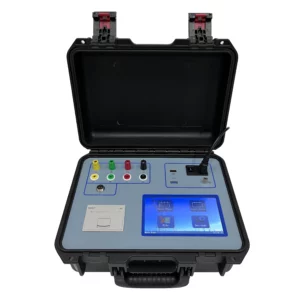Posted on November 3, 2023
What safety precautions should be followed when using circuit breaker testers, especially in high-voltage environments?
Using circuit breaker testers, especially in high-voltage environments, requires strict adherence to safety precautions to protect personnel and equipment.
Here are important safety guidelines to follow:
- Training and Qualifications:
- Ensure that personnel operating circuit breaker testers are properly trained and qualified for the task. They should understand the equipment, testing procedures, and safety protocols.
- PPE (Personal Protective Equipment):
- Wear appropriate personal protective equipment, including safety glasses, gloves, and flame-resistant clothing. In high-voltage environments, additional PPE may be necessary, such as arc flash suits and face shields.
- Electrical Safety Procedures:
- Verify that the circuit breaker is de-energized and isolated from the power source before conducting any tests. Follow lockout/tagout procedures to prevent accidental energization.
- Grounding:
- Establish proper grounding to minimize the risk of electric shock and to provide a safe path for fault currents. Ensure that the grounding connections are secure and effective.
- Voltage Measurement:
- Before testing, use a voltage detector to confirm that the circuit is de-energized. Double-check the absence of voltage to eliminate the possibility of residual energy.
- Test Environment:
- Perform tests in a controlled and secure environment to prevent unauthorized access and protect personnel from potential hazards. Clear the area of non-essential personnel.
- Safety Interlocks:
- Use circuit breaker testers equipped with safety interlocks and built-in safety features. Ensure that these interlocks are functional and not bypassed.
- Insulation:
- Check the insulation of test leads, cables, and the tester itself to ensure they are in good condition and rated for the voltage being tested.
- Arc Flash Protection:
- In high-voltage environments, be aware of the potential for arc flash events. Use arc flash protective clothing and equipment as necessary and in accordance with relevant standards.
- Proper Tools and Equipment:
- Use high-quality, well-maintained test equipment and tools. Faulty equipment can pose a safety risk.
- Documentation:
- Maintain comprehensive records of all tests and their results. This documentation can be critical for future maintenance and safety assessments.
- Emergency Response:
- Have a well-defined emergency response plan in place in case of accidents or unexpected events. Ensure that all personnel know how to respond to various emergency scenarios.
- Compliance with Standards:
- Follow safety standards and guidelines relevant to the specific testing environment, such as those from organizations like ANSI, IEEE, and NFPA.
- Continuous Monitoring:
- Continuously monitor the testing process and the surrounding environment for any signs of trouble, such as abnormal sounds or unusual odors.
- Post-Test Verification:
- After testing, verify that the circuit breaker and associated components have been properly restored and that the equipment remains in a safe condition.
Safety is of utmost importance when working with circuit breaker testers, particularly in high-voltage situations. Always prioritize the well-being of personnel and ensure that testing procedures are conducted in accordance with industry best practices and safety standards.
How can circuit breaker testers be used to evaluate the performance and condition of circuit breakers in power distribution systems?
Circuit breaker testers are essential tools for evaluating the performance and condition of circuit breakers in power distribution systems.
Here are the key steps and procedures for using these testers effectively:
- Preparation:
- Ensure that the circuit breaker is de-energized and properly isolated before testing. Follow lockout/tagout procedures to prevent accidental energization.
- Visual Inspection:
- Examine the circuit breaker visually to check for any obvious signs of damage, corrosion, loose connections, or worn parts.
- Timing and Motion Analysis:
- Use the circuit breaker tester to measure the timing and motion of the circuit breaker’s opening and closing operations. circuit breaker tester Timing analysis helps determine if the breaker operates within specified time limits.
- Contact Resistance Measurement:
- Measure the contact resistance of the breaker’s contacts using the tester. Elevated contact resistance can indicate worn or damaged contacts that may not conduct current properly.
- Operational Testing:
- Test the breaker’s performance under various operating conditions. This may include testing at different loads and checking the breaker’s response to fault conditions.
- Insulation Resistance Testing:
- Measure the insulation resistance of the circuit breaker to identify any insulation issues, which could lead to faults or reduced performance.
- Overcurrent and Short-Circuit Testing:
- Use the circuit breaker tester to apply overcurrent or short-circuit conditions to evaluate the breaker’s ability to interrupt current safely and reliably.
- Contact Travel Analysis:
- Analyze the travel characteristics of the circuit breaker’s contacts to ensure they make and break connections as intended.
- Vibration and Shock Testing:
- Subject the circuit breaker to vibration and shock tests to assess its ability to withstand mechanical stress, such as in seismic-prone areas.
- Partial Discharge Detection:
- Employ the circuit breaker tester to detect partial discharges within the breaker, which can be indicative of insulation breakdown.
- Recovery Voltage Measurement:
- Measure the recovery voltage across the breaker contacts after interruption to ensure it remains within specified limits.
- Documentation and Data Analysis:
- Record all test results and data for future reference and analysis. Comprehensive documentation is crucial for assessing the breaker’s condition and making informed decisions.
- Comparison with Manufacturer Specifications:
- Compare the test results with the manufacturer’s specifications and industry standards to determine if the circuit breaker meets the required performance criteria.
- Maintenance and Repair:
- If any issues are identified during testing, schedule appropriate maintenance or repairs to rectify the problems and ensure the circuit breaker’s reliability.
- Post-Test Verification:
- After maintenance or repairs, retest the circuit breaker to confirm that it meets the required performance standards.
Circuit breaker testers provide valuable insights into the condition and performance of circuit breakers, helping to ensure the reliability of power distribution systems. Regular testing and maintenance are essential to prevent unexpected failures and to maintain the safety and efficiency of electrical networks.


